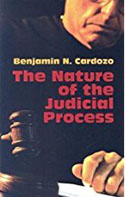responding
to such an inquiry. In the text he admits that probably most judges
do not formally or consciously go through the analytical processes that
he describes, but they do go through some of them subconsciously.
The
book is not well known amongst the legal profession or among judges in
present times. In my 27 years of working with judges, both domestic and
foreign, and becoming acquainted with the subject and texts to which they
are exposed after their judicial appointments, I have never heard mention
of Justice Cardozo’s book even one time. If his book has been ignored,
as I expect it has been, that is a real tragedy, because the book offers
so much of enlightenment about the craft of judging, and how judges
should go about their work of deciding cases.
In
the Introduction, Justice Cardozo offers some general comments about judging
under the common law, the differences between constitutional and
statutory law, and the role of precedent and stare decisis in the common
law.
The
justice approaches the judicial process by examining of four approaches to
judging: the method of philosophy, the method of history, the method of
tradition, and the method of sociology. Each method is examined carefully.
Examples are provided to illustrate the validity and usefulness
of each method, and how most cases involve the use of more than
one method.
In
the Conclusion, Justice Cardozo calls the law an “ageless process.” He argues that
“we,” meaning himself and his contemporaries, worry too much about the
mistakes that might be made in the judicial process. Perhaps one of his methods
is consciously or unconsciously used by the judge that produces bad
law or an erroneous result. But, he says, the law has a way, over time, of
shedding the bad, and retaining what is the good. His actual words are:
Ever
in the making, as law is developed through the centuries, is
this new faith which silently and steadily effaces our mistakes and
our eccentricities. I sometimes think we worry ourselves over
much about the enduring consequences of our errors. They
make work a little confusion for a time. In the end, they will
be modified and corrected or their teachings ignored. The future
takes care of such things. In the endless process of testing and
retesting, there is a constant rejection of the dross, and a
constant retention of whatever is pure and sound and fine.
Justice
Cardozo’s words provide comfort to those who are afflicted by
the turmoil of the present, and by the present steering of the ship of state off
course. The judges of the United States should examine their methods of deciding
cases, and use the guides provided by Justice Cardozo in the effort
to steer the ship of state back on course.

 International
Judicial Monitor
International
Judicial Monitor